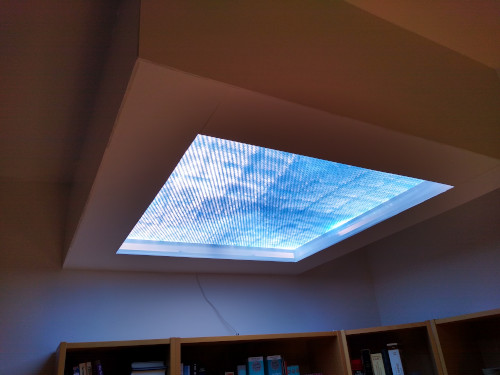
Sunlight has a number of properties that sets it apart from other light sources. It has a wide spectrum of wavelengths that results in a vivid rendering of colors and it provides an illuminance of up to 100.000 lumen per square meter. While the sunlight travels through the earth’s atmosphere, shorter (blue) wavelengths experience Rayleigh scattering that colors our sky blue and gives the remaining sunlight a slightly warmer color. In addition, sunrays are parallel. This means, that the shadow of an object under sunlight has a fixed size that does not depend on the distance between object and shadowed surface. Together, these characteristics give sunlight a specific quality that humans perceive subliminally, often resulting in increased vigilance and improved mood.
A small number of companies have specialized in reproducing the qualities of sunlight in artificial lighting. However, their products are quite expensive and often require an integration directly into the structure of the respective building. I wanted to design a ceiling light that mimics a skylight while retaining a relatively low profile (Fig. 1). To create an artificial sunlight one needs basically three things: a wide-spektrum light source, a way to make the light rays parallel, and a way to simulate Rayleigh scattering. As a light source I chose Nichia NFCWJ096B-V2 chip-on-board (COB) LEDs that have a color temperature of 6.500K and a color rendering index (CRI) of >90. The latter is a measure how well the color spectrum of the light source equals that of the sun. There are versions of the LEDs I used that have a CRI >95, but they weren’t available to me at the time of building.
I opted to use parabolic mirrors to make the light parallel. My aim was to have a core illuminated area of about 1m², which in turn meant that my total mirror surface had to equal this size. Using a single mirror would have required either a distant focal point or a high profile of the mirror itself. Both alternatives would interfere with the low profile of the ceiling light I was aiming for. As a solution I designed four mirrors that align seamlessly and have close, off-center focal points (Fig. 2a/b). Each mirror is split into multiple pieces that were printed on a 3D printer and later assembled using tongue and groove connections between the pieces. The mirror surface is created by a highly reflective film that is held in place with double-sided tape. For each mirror a LED is mounted in the mirror’s focal point using a 3D printed bracket and a low-cost CPU heatsink for cooling. Each LED puts out about 3.750 Lumen at 25 Watts resulting in about 15.000 Lumen at 100 Watts in total for the entire light, i.e., about 15% of the sun’s peak illuminance.
Commerical artificial sunlights recreate the Rayleigh scattering by using acrylic glas that contains zinc nanoparticles. Such nanoparticles are not readily available in the market (the zinc oxide pigments one might buy at an artist store are not fine enough). Some time ago I tried to fabricate zinc oxide nanoparticles using electrolysis but failed to achieve any usable results. One alternative to emulate Rayleigh scattering is to cheat a bit and use the Tyndall effect, which refers to the scattering by particles in a suspension, e.g., milk or soap in water. Since I did not want to have any kind of liquid-filled container hanging from my ceiling, i cheated a bit more and emulated the Rayleigh scattering by lining the insight of the light with skyblue film and creating a hexagonal mesh as an aperture (Fig. 2c). The mesh is 3D printed with a light-blue, translucent material.
The final artifical skylight creates a pretty convincing illusion of direct, overhead sunlight. It certainly does not reach the perfection of commercial artificial sunglights, but it also only costs about 1% of them. In particular, the view of the “simulated sun” at infinite focus is quite remarkable. Video 1 gives an impression of this.





